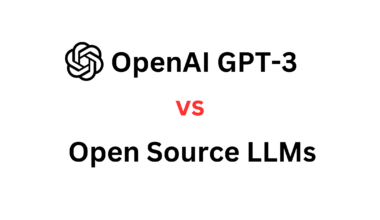In the ever-evolving landscape of advanced language models, two titans have emerged, each with its own set of impressive capabilities and unique strengths. In this comparative exploration, we delve into the key differences between GPT-4 and Llama 2, shedding light on their distinct attributes and potential impact in the world of AI and natural language processing.
GPT-4, the brainchild of OpenAI, boasts unprecedented parameters and a groundbreaking ability to process not just text but also images, offering a versatile tool for a multitude of applications.
On the other side of the spectrum, LLaMA 2, born from a collaboration between Meta and Microsoft, shines with its exceptional multilingual support, computational efficiency, and open-source nature, inviting researchers and developers to explore its intricacies.
GPT-4 Overview
GPT-4, released in March 2023 by OpenAI, represents the latest and most powerful entrant in the realm of Language Model (LLM) technology. While it undoubtedly stands as a formidable advancement over its predecessor, GPT-3.5, what truly sets it apart is its groundbreaking ability to process not just text but also image inputs.
This multimodal capacity positions GPT-4 as a versatile tool for a wide range of applications, expanding its utility far beyond what was possible with its forerunners. However, it’s important to note that this enhanced capability comes at a cost, making GPT-4 the most expensive LLM available in the market.
GPT-4 Variants: ChatGPT Plus and gpt-4-32K
OpenAI has made GPT-4 available in two distinct variants, each tailored to different user needs. The first variant, known as “gpt-4-8K,” powers ChatGPT Plus, a subscription service that leverages the capabilities of this model to offer enriched conversational experiences. The second variant, “gpt-4-32K,” is designed to handle more extensive and demanding tasks, catering to users with advanced requirements.
At first glance, it might seem that GPT-4’s claim as the “most powerful LLM” should render discussions about its competition, such as Llama 2, obsolete. However, the situation isn’t as straightforward as it appears. The comparative merits of these models require a deeper examination.
GPT-4 Capabilities: A Multifaceted Asset
GPT-4’s primary forte lies in its exceptional ability to generate human-like text based on prompts, a feature that proves invaluable in various applications, ranging from chatbots that engage in natural conversations to content generation for diverse purposes.
Its sheer size and prowess represent a substantial leap from previous iterations, and it has excelled in human-designed exams and traditional Natural Language Processing (NLP) benchmarks, attesting to its remarkable capabilities. What truly sets GPT-4 apart is its status as a “multimodal marvel.”
Unlike its predecessors, GPT-4 can seamlessly handle both image and text data, revolutionizing the landscape of applications it can cater to. This newfound capability makes it highly adaptable for tasks such as dialogue systems and text summarization, where the fusion of text and image processing proves to be a game-changer.
Nonetheless, like its predecessors, GPT-4 isn’t without its limitations. Users must exercise caution when employing it in applications where high reliability is paramount. These limitations, though worth noting, do not diminish its significance or utility in the rapidly evolving field of AI and language processing.
Llama 2 Overview
Llama 2, the second generation of Meta’s Large Language Model (LLM), was introduced on July 18, 2023, as a remarkable collaboration between Meta and Microsoft. This advanced language model is a testament to the continued evolution of generative AI models and their potential impact on various natural language processing (NLP) tasks.
Llama 2 is available in multiple sizes, catering to a range of computational needs and applications. It comes in 7B, 13B, and a staggering 70B parameter versions, with both pretrained and fine-tuned variations. It’s worth mentioning that Meta has trained a 34B parameter version as well, though its release has been temporarily postponed.
One of Llama 2’s standout features is its exceptional performance when compared to other open-source models. In benchmark tests against models like EleutherAI’s GPT-Neo and GPT-J, Llama 2 consistently demonstrates superior results across various NLP tasks.
For instance, it outperforms in renowned benchmarks like SuperGLUE, showcasing its advanced comprehension and response generation capabilities. Notably, Meta has invested substantial efforts in enhancing Llama 2’s safety through meticulous data annotations, iterative evaluations, and rigorous security assessments.
Llama 2’s capabilities are extensive and versatile. It leverages a reward modeling system, encompassing two reward models—one for helpfulness and another for safety. This unique approach empowers tools utilizing the Llama 2 language model to generate both safe and useful output. Its broad range of applications includes human-like conversation, translation, summarization, text generation, question answering, story generation, and much more.
Meta AI has been transparent about the data used to train Llama 2. While the exact size of the dataset remains undisclosed, it is known to be a composite of publicly available online sources. Crucially, Meta has emphasized that no private or personal information was used during the model’s training process, underscoring its commitment to privacy and data ethics.
Learn more about Llama 2 here.
Llama 2 vs GPT-4 Comparison
The following table shows the main differences between Llama 2 and GPT-4:
| Feature | Llama 2 | GPT-4 |
| Training data | 2 trillion tokens | 175 billion tokens |
| Model size | 70B parameters | 175B parameters |
| Language support | 20 languages | 26 languages |
| Capabilities | Generating text, translating languages, writing different kinds of creative content, answering questions | Generating text, translating languages, writing different kinds of creative content, answering questions, comprehending PDFs, coding, and more |
| Strength | More efficient, easier to use, less likely to generate offensive or harmful content | More versatile, can perform more complex tasks |
| Weaknesses | Smaller dataset, fewer languages support | More expensive, more difficult to learn how to use |
| Availability | Open-source, available through the Meta AI platform | Commercially available, available through OpenAI’s API |
Let’s discuss all of them in-detail!
9 Key Differences between Llama2 and GPT-4
Here are the main key differences between GPT-4 and Llama 2 based on the following features:
1. Model Size and Parameters
GPT-4 Parameters: The exact parameter count of GPT-4 is not officially disclosed by OpenAI. Estimates range from 1 to 1.76 trillion parameters. Some experts suggest it may consist of eight models, each with 220 billion parameters. Regardless, it is significantly larger and more complex than Llama 2.
Llama 2 Parameters: Llama 2 comes in various configurations, including 7 billion, 13 billion, and 70 billion parameters. Even the largest variant of Llama 2 (70B) is dwarfed in comparison to the potential parameter count of GPT-4. Llama 2’s model size is substantially smaller.
2. Multilingualism
GPT-4 Multilingualism: GPT-4 is primarily optimized for English and is noted to have poor performance in languages other than English. It is not the ideal choice for multilingual tasks.
Llama 2 Multilingualism: Llama 2 is designed to perform well in multiple languages. It has been praised for its multilingual capabilities, making it a suitable choice for projects that require support for various languages.
3. Token Limit
GPT-4 Token Limit: GPT-4 offers models with a significantly larger token limit compared to Llama 2. While the exact token limit is not specified, it’s mentioned that the base variant of GPT-4 doubles the token limit of GPT -3.5-turbo.
Llama 2 Token Limit: Llama 2 has a token limit similar to the base variant of GPT-3.5-turbo. This means that it can process shorter inputs and generate shorter outputs compared to GPT-4.
4. Creativity
GPT-4 Creativity: GPT-4 is described as having a higher level of creativity in generating text. When asked to generate content like poems, GPT-4 uses sophisticated vocabulary, metaphors, and a wide array of expressions, resembling the work of an experienced writer.
Llama 2 Creativity: While Llama 2 can also generate creative text, its creativity is noted to be at a lower level compared to GPT-4. Its outputs are described as falling closer to a basic or school-level assessment.
5. Accuracy and Task Complexity
GPT-4 Accuracy and Task Complexity: GPT-4 outperforms Llama 2 in various benchmark scores, including complex tasks. It is considered a more advanced model and excels in tasks that require a high level of accuracy and complexity.
Llama 2 Accuracy and Task Complexity: Llama 2 performs commendably and is competitive with GPT-3.5 in terms of accuracy. It uses a technique called Ghost Attention (GAtt) to improve accuracy and control over dialogue. However, it may not match GPT-4’s performance in the most complex tasks.
6. Speed and Efficiency
GPT-4 Speed and Efficiency: Llama 2 is noted to be faster and more resource-efficient compared to GPT-4. GPT-4, due to its larger size and complexity, may require more computational resources, potentially making it slower in comparison.
Llama 2 Speed and Efficiency: Llama 2 excels in terms of computational agility, offering faster inference times and more efficient resource utilization. Its grouped-query attention innovation provides a better tradeoff between accuracy and inference speed compared to GPT-4. This efficiency is attributed to Llama 2’s architectural innovations, such as grouped-query attention, which is specifically designed to enhance inference scalability.
7. Usability
GPT-4 Usability: GPT-4 is accessible through a commercial API, primarily targeting expert developers with a strong track record. It is not as openly available as Llama 2.
Llama 2 Usability: Llama 2 is integrated into the Hugging Face platform, making it more accessible to developers and researchers. However, it may require special permission for use by large companies like Google.
8. Training Data
GPT-4 Training Data: While the exact number of tokens used to train GPT-4 is not disclosed, it’s estimated to have been trained on a massive dataset of approximately 13 trillion tokens. This extensive training data contributes to its broad knowledge base.
Llama 2 Training Data: Llama 2, in contrast, was trained on 2 trillion tokens from publicly available sources. It has undergone data cleaning, updates, and technical enhancements, but its training data is substantially smaller than GPT-4’s.
9. Performance Metrics
GPT-4 outperforms Llama 2 in various benchmark scores, including the HumanEval (coding) benchmark, where it significantly surpasses Llama 2 in coding skills. This indicates its higher performance in specific tasks.
GPT-4 is superior to Llama 2 in mathematical and reasoning tasks. It has better capabilities for handling complex mathematical and logical tasks, which can be crucial for certain applications. GPT-4 excels in few-shot learning scenarios, such as the 5-shot MMLU benchmark. It demonstrates a strong ability to handle limited data situations and complex tasks.
Takeaways
The comparison between GPT-4 and LLaMA 2 reveals a fascinating contrast in the world of advanced language models.
GPT-4 stands out for its massive parameters, versatility, and human-like interaction capabilities, closely emulating human comprehension. Conversely, LLaMA 2 impresses with its exceptional multilingual support, computational efficiency, and open-source nature. These models mark a significant leap in AI, pushing the boundaries of language understanding and generation.


